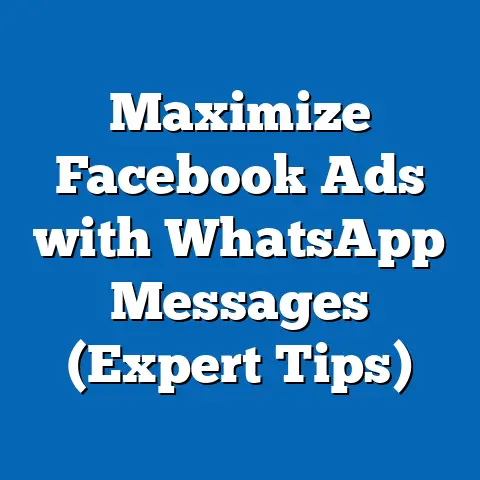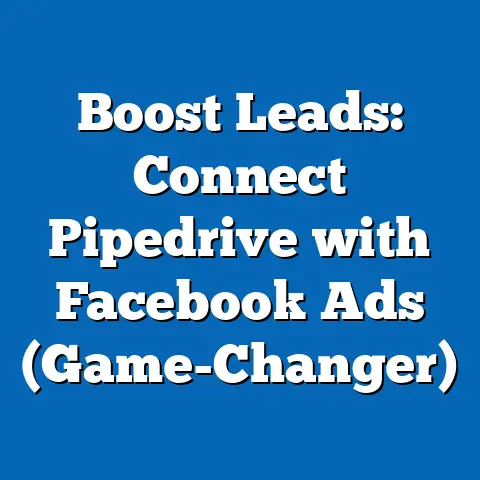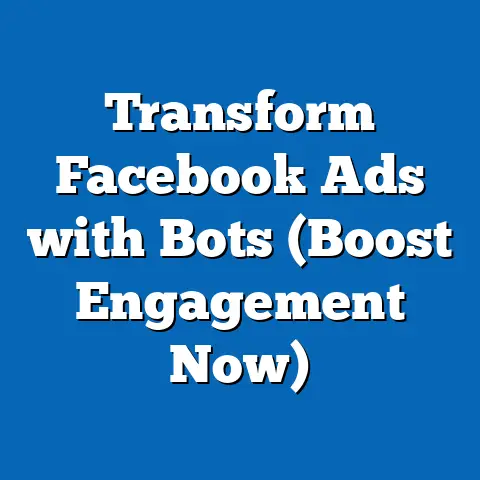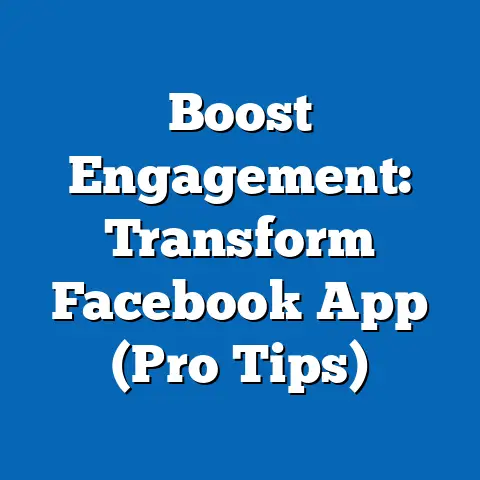Transform Facebook Video Ads (Sizzling Engagement Strategies)
Facebook. It’s a platform most of us use daily, but are you truly harnessing its power for your business? I remember when Facebook first launched ads. Back then, it felt like shouting into a void. But things have changed dramatically. In today’s digital marketing landscape, Facebook video ads stand out as a potent tool for capturing attention and driving results. I’ve seen firsthand how a well-crafted video can transform a struggling campaign into a lead-generating machine.
Think about it: we’re bombarded with information every second. Static images and blocks of text often get lost in the noise. But video? Video grabs you. It tells a story, evokes emotions, and communicates complex ideas in a concise, engaging way. It’s no wonder that video content consistently outperforms other ad formats on Facebook.
Statistics back this up. According to recent reports, video ads boast significantly higher engagement rates than static image ads. We’re talking about more likes, shares, comments, and, most importantly, conversions. Moreover, the return on investment (ROI) for video ads can be substantially higher when compared to traditional advertising methods. I’ve personally witnessed campaigns where video ads generated 3x the leads at half the cost compared to static image ads.
But simply creating a video isn’t enough. You need “sizzling engagement strategies” – the secret sauce that transforms standard video ads into high-performing marketing tools. These strategies encompass everything from crafting unique content and optimizing video quality to mastering targeting and analyzing performance.
- Understand the evolving landscape of Facebook video ads.
- Craft unique and compelling video content that resonates with your target audience.
- Enhance video quality and production value without breaking the bank.
- Optimize your videos for maximum engagement.
- Master targeting and retargeting strategies to reach the right people.
- Analyze performance and iterate on your success.
Get ready to transform your Facebook video ads from bland to brilliant. Let’s dive in!
Understanding the Landscape of Facebook Video Ads
The world of Facebook video ads is constantly evolving. It’s not just about throwing a video up and hoping for the best. Understanding the history, the different ad types, and how user behavior influences performance is crucial.
The Evolution of Facebook Video Ads
I remember the early days of Facebook ads – they were clunky, intrusive, and often irrelevant. But Facebook has come a long way. The platform has continuously refined its advertising offerings, adapting to changes in user behavior and technological advancements.
Initially, video ads were a novelty. Now, they’re a staple. This shift is driven by a few key factors:
- Increased mobile usage: People are consuming content primarily on their smartphones, and video is perfectly suited for mobile viewing.
- Shorter attention spans: In a world of constant distractions, video can capture attention quickly and deliver key messages in a concise format.
- Algorithm updates: Facebook’s algorithm prioritizes engaging content, and video consistently ranks high in terms of engagement.
Staying informed about these changes is essential. Facebook frequently updates its ad policies, targeting options, and best practices. What worked last year might not work this year.
Types of Facebook Video Ads
Facebook offers a variety of video ad formats, each with its unique strengths and weaknesses. Understanding these formats is key to choosing the right one for your campaign goals.
- In-Stream Ads: These ads appear within other videos on Facebook Watch. They’re typically short (15 seconds or less) and are best suited for brand awareness and quick promotions. I’ve found these to be particularly effective when targeting users who are already engaged with similar video content.
- Feed Ads: These ads appear directly in users’ news feeds, blending seamlessly with organic content. They can be longer than in-stream ads and are ideal for storytelling and driving traffic to your website. I once ran a campaign using a longer-form feed ad that told the story of our company’s founding, and it generated a huge spike in website visits and brand awareness.
- Stories Ads: These full-screen, vertical videos appear between users’ Stories. They’re highly engaging and perfect for showcasing products, running contests, or driving immediate action. I’ve seen brands use Stories ads to create interactive polls and quizzes, which significantly boost engagement.
- Collection Ads: These ads combine a video with a selection of products, allowing users to browse and purchase directly from the ad. They’re ideal for e-commerce businesses looking to drive sales. I’ve used Collection ads to showcase our latest product lines, and they’ve consistently outperformed other ad formats in terms of conversion rates.
- Instant Experience Ads: These are full-screen, mobile-optimized ads that open when someone clicks on a video ad. They can include multiple videos, images, and text, providing a rich and immersive experience. I’ve used Instant Experience ads to create virtual tours of our facilities, which have been incredibly effective in building trust and transparency.
Aligning Video Content with Your Target Audience
Creating compelling video content is only half the battle. You need to ensure that your videos resonate with your target audience’s preferences and behaviors. This requires a deep understanding of your audience, including their demographics, interests, pain points, and motivations.
I always start by creating detailed audience personas. These personas represent your ideal customers and help you tailor your messaging and content to their specific needs. For example, if you’re targeting millennials, you might focus on creating authentic, relatable videos that address their concerns about sustainability and social impact. If you’re targeting baby boomers, you might focus on creating videos that showcase the value and reliability of your products or services.
Analyzing the Competitive Landscape
Before launching your video ad campaign, take some time to analyze what your competitors are doing. What types of videos are they creating? What messages are they using? How are they targeting their audience?
This research can provide valuable insights and help you identify opportunities to stand out from the crowd. I often use Facebook’s Ad Library to see what ads my competitors are running. This tool allows you to search for ads by keyword, page, or location, giving you a glimpse into their advertising strategies.
Key Takeaway: Understanding the evolution of Facebook video ads, the different ad formats available, and your target audience is crucial for creating successful campaigns. Don’t skip this foundational step!
Crafting Unique Video Content
In the crowded digital landscape, originality is your superpower. Your video content needs to be more than just informative; it needs to be captivating, memorable, and uniquely you. I’ve learned that the best video ads are the ones that dare to be different.
The Importance of Originality and Creativity
Let’s face it: people are bombarded with ads every day. Most of them are forgettable, generic, and easily ignored. To break through the noise, your video content needs to be truly original and creative.
I’m not talking about simply copying what everyone else is doing. I’m talking about finding a unique angle, a fresh perspective, or a surprising twist that will capture your audience’s attention and leave a lasting impression.
Brainstorming Unique Concepts
Coming up with unique video concepts can be challenging, but it’s also incredibly rewarding. Here are some methods I use to spark creativity:
- Start with your audience’s pain points: What problems are they facing? What challenges are they trying to overcome? Your video can offer solutions, insights, or inspiration.
- Think outside the box: Don’t be afraid to experiment with different formats, styles, and tones. Try humor, satire, animation, or even a documentary-style approach.
- Look for inspiration in unexpected places: Read books, watch movies, listen to podcasts, and pay attention to the world around you. You never know where you’ll find your next great idea.
- Collaborate with others: Brainstorming with a team can generate a wider range of ideas and perspectives. I often hold brainstorming sessions with my colleagues, and we always come up with something amazing.
The Power of Storytelling
Storytelling is one of the most powerful tools you can use in your video ads. A well-told story can evoke emotions, build connections, and make your message more memorable.
I’ve found that the best stories are the ones that are authentic, relatable, and emotionally resonant. They don’t necessarily have to be dramatic or elaborate. They can be simple, personal stories that showcase your brand’s values, mission, or unique selling proposition.
For example, a local bakery might create a video ad that tells the story of how their family recipes have been passed down through generations. A non-profit organization might create a video ad that highlights the impact of their work on the lives of real people.
Successful Case Studies
Let’s look at some examples of brands that have used unique storytelling techniques in their video campaigns:
- Dove’s “Real Beauty” campaign: This campaign challenged conventional beauty standards and celebrated the diversity of women. The video ads featured real women of all shapes, sizes, and ethnicities, sharing their personal stories and perspectives. The campaign was a huge success, generating millions of views and sparking a global conversation about beauty and self-acceptance.
- Always’ “Like a Girl” campaign: This campaign challenged the negative connotations associated with the phrase “like a girl.” The video ads featured young girls and women demonstrating their strength, skill, and determination. The campaign was incredibly empowering and inspiring, and it helped to change the way people think about gender stereotypes.
- Airbnb’s “Belong Anywhere” campaign: This campaign highlighted the power of travel to connect people and cultures. The video ads featured real Airbnb hosts and guests, sharing their experiences and perspectives. The campaign was incredibly heartwarming and inspiring, and it helped to build trust and loyalty among Airbnb users.
Key Takeaway: Don’t settle for generic video content. Embrace originality, creativity, and storytelling to create ads that truly resonate with your audience.
Enhancing Video Quality and Production Value
While a great story is essential, poor production quality can sink even the best ideas. Viewers are discerning; they expect a certain level of professionalism. I’ve learned that investing in video quality pays off in increased engagement and a more positive brand perception.
The Significance of High Production Quality
In today’s digital age, viewers are accustomed to high-quality video content. They expect crisp visuals, clear audio, and professional editing. If your video looks amateurish or poorly produced, it will likely be ignored or dismissed.
High production quality not only captures attention but also conveys professionalism and credibility. It tells your audience that you care about your brand and that you’re willing to invest in creating a positive experience for them.
Tips for Creating Visually Appealing Videos
Creating visually appealing videos doesn’t have to be expensive or complicated. Here are some simple tips that can make a big difference:
- Lighting: Good lighting is essential for creating visually appealing videos. Use natural light whenever possible, or invest in some basic lighting equipment.
- Sound: Clear audio is just as important as crisp visuals. Use a good microphone and avoid shooting in noisy environments.
- Composition: Pay attention to the composition of your shots. Use the rule of thirds to create visually balanced and interesting frames.
- Editing: Professional editing can polish your videos and make them more engaging. Use editing software to trim clips, add transitions, and incorporate text and graphics.
Professional Tools and Software
There are many professional tools and software options available for video production. Here are some of my favorites:
- Cameras: For high-quality video, consider using a DSLR or mirrorless camera. These cameras offer excellent image quality and allow you to control various settings, such as aperture, shutter speed, and ISO.
- Microphones: For clear audio, invest in a good microphone. Lavalier microphones are great for interviews, while shotgun microphones are ideal for capturing ambient sound.
- Lighting: For professional lighting, consider using softboxes or LED panels. These lights provide even, diffused lighting that minimizes shadows and glare.
- Editing Software: There are many excellent video editing software options available, such as Adobe Premiere Pro, Final Cut Pro, and DaVinci Resolve. These programs offer a wide range of features and tools for editing, color correcting, and adding effects to your videos.
Balancing High-Quality Production with Authenticity
While high production quality is important, it’s also essential to maintain authenticity. Sometimes, raw, unpolished content can resonate with audiences more than slick, overly produced videos.
The key is to find a balance between quality and authenticity. Don’t be afraid to show your brand’s personality and let your audience see the real you.
Key Takeaway: Invest in video quality, but don’t sacrifice authenticity. Find a balance that showcases your brand’s personality while maintaining a professional and engaging experience.
Optimizing Video for Engagement
You’ve created a visually stunning and compelling video. Now what? Getting people to actually watch and engage with it is the next hurdle. I’ve found that even the best videos can fall flat if they’re not properly optimized for engagement.
The Importance of the First Few Seconds
The first few seconds of your video are crucial. They’re your opportunity to grab viewers’ attention and convince them to keep watching. If you don’t hook them in the first few seconds, they’ll likely scroll past your video.
I often use a variety of techniques to create a strong opening:
- Ask a compelling question: This can pique viewers’ curiosity and make them want to learn more.
- Show a visually striking image or scene: This can capture viewers’ attention and draw them into your video.
- Make a bold statement: This can challenge viewers’ assumptions and make them want to hear what you have to say.
- Start with a quick, attention-grabbing clip: This can be a humorous, exciting, or intriguing moment that will keep viewers watching.
Crafting Powerful Hooks and Calls-to-Action (CTAs)
A hook is a statement or question that grabs viewers’ attention and makes them want to keep watching. A call-to-action (CTA) is an instruction that tells viewers what you want them to do after watching your video.
I always include a clear and compelling CTA in my video ads. This can be anything from visiting your website to signing up for your email list to making a purchase.
The Role of Captions and Subtitles
Captions and subtitles are essential for enhancing accessibility and viewer comprehension. They allow people to watch your videos even if they’re in a noisy environment or if they don’t speak the same language as you.
I always add captions and subtitles to my video ads. This not only makes my videos more accessible but also increases engagement. Studies have shown that videos with captions are watched for longer periods of time and have higher engagement rates.
Creating Compelling Thumbnails
Thumbnails are the images that appear before your video starts playing. They’re your opportunity to attract clicks and encourage people to watch your video.
I always create custom thumbnails that are visually appealing and relevant to the content of my video. I also make sure that my thumbnails are clear, easy to read, and optimized for mobile viewing.
Key Takeaway: Optimize your videos for engagement by crafting powerful hooks, including clear CTAs, adding captions and subtitles, and creating compelling thumbnails.
Targeting and Retargeting Strategies
You’ve got a fantastic video, but who are you showing it to? Effective targeting is the key to reaching the right audience and maximizing your ad spend. I’ve learned that a well-targeted video ad campaign can generate significantly higher ROI than a poorly targeted one.
The Importance of Audience Targeting
Facebook’s targeting options are incredibly powerful. You can target users based on a wide range of factors, including demographics, interests, behaviors, and connections.
I always take the time to define my target audience before launching a video ad campaign. This involves creating detailed audience personas and identifying the key characteristics that make them likely to be interested in my products or services.
Custom Audiences and Lookalike Audiences
Facebook’s Custom Audiences and Lookalike Audiences are two of the most effective targeting tools available.
- Custom Audiences: These allow you to target users who have already interacted with your business, such as website visitors, email subscribers, or customers. I often create Custom Audiences based on website traffic, email lists, and customer data.
- Lookalike Audiences: These allow you to target users who are similar to your existing customers. I often create Lookalike Audiences based on my Custom Audiences.
Retargeting Strategies
Retargeting is the process of showing ads to users who have already engaged with your previous video content. This is a highly effective way to keep your brand top of mind and drive conversions.
I often create retargeting campaigns that show different ads to users based on their level of engagement with my previous videos. For example, I might show a different ad to users who watched 25% of my video than I would to users who watched 75% of my video.
Key Takeaway: Master Facebook’s targeting and retargeting options to reach the right audience and maximize your ad spend.
Analyzing Performance and Iterating on Success
You’ve launched your video ad campaign. Now it’s time to track your results and make adjustments as needed. I’ve learned that continuous analysis and iteration are essential for maximizing the performance of your video ads.
Key Metrics to Track
There are several key metrics that you should track to understand the performance of your video ads:
- Watch Time: This measures how long people are watching your video.
- Engagement Rate: This measures how many people are liking, commenting, and sharing your video.
- Conversion Rate: This measures how many people are taking the desired action after watching your video (e.g., visiting your website, signing up for your email list, making a purchase).
- Cost Per View (CPV): This measures how much you’re paying for each view of your video.
- Return on Ad Spend (ROAS): This measures how much revenue you’re generating for every dollar you’re spending on ads.
Interpreting Facebook Ads Manager Data
Facebook Ads Manager provides a wealth of data about your video ad performance. Take the time to learn how to interpret this data and use it to inform your future video ad strategies.
I often use Facebook Ads Manager to track my key metrics, identify trends, and make adjustments to my targeting, creative, and bidding strategies.
The Iterative Process
The key to maximizing the performance of your video ads is to embrace an iterative process. This involves continuously testing different video formats, messages, and targeting options to see what works best.
I often run A/B tests to compare different versions of my video ads. This allows me to identify the most effective elements and optimize my ads for maximum performance.
Key Takeaway: Continuously analyze your video ad performance and iterate on your strategies to maximize engagement and ROI.
Conclusion
We’ve covered a lot of ground in this guide, from understanding the evolving landscape of Facebook video ads to crafting unique content, optimizing video quality, mastering targeting, and analyzing performance.
Remember, transforming your Facebook video ads into powerful engagement tools requires a combination of creativity, quality, and strategic thinking. Don’t be afraid to experiment, take risks, and learn from your mistakes.
Here’s a quick recap of the key points:
- Uniqueness: Stand out from the crowd with original and creative video content.
- Quality: Invest in video quality to convey professionalism and credibility.
- Targeting: Reach the right audience with effective targeting and retargeting strategies.
- Engagement: Optimize your videos for engagement by crafting powerful hooks, including clear CTAs, adding captions and subtitles, and creating compelling thumbnails.
- Analysis: Continuously analyze your video ad performance and iterate on your strategies to maximize engagement and ROI.
Now it’s your turn. I encourage you to embrace creativity and analytics to create your own sizzling video ad campaigns. Share your experiences with Facebook video ads in the comments below. What strategies have worked best for you? What challenges have you faced?
And remember, the world of Facebook advertising is constantly evolving. Stay informed, stay creative, and stay focused on delivering value to your audience. Good luck!






